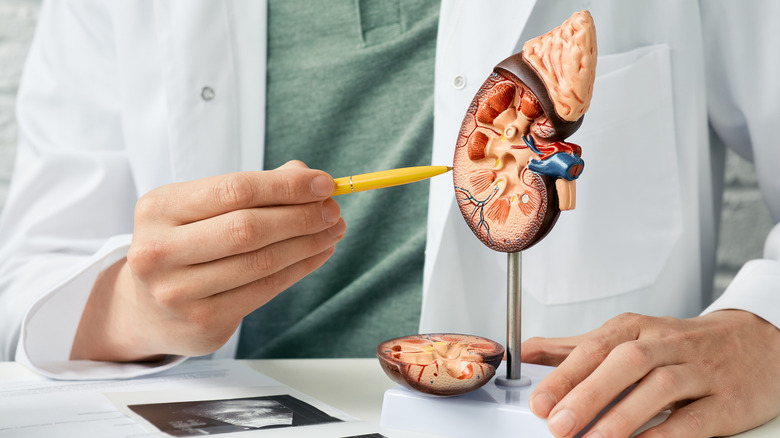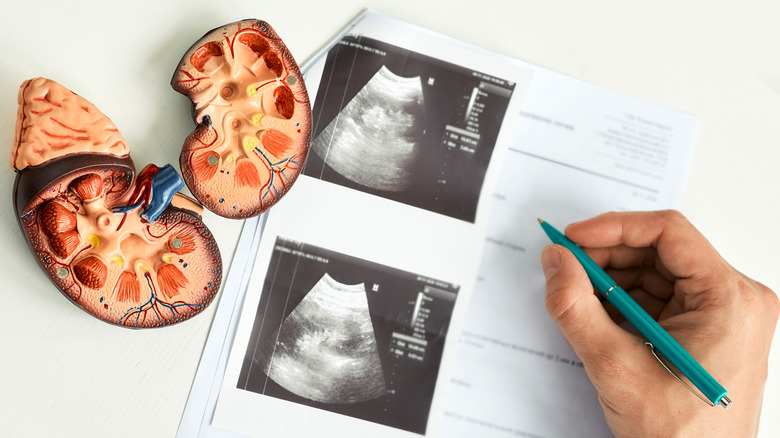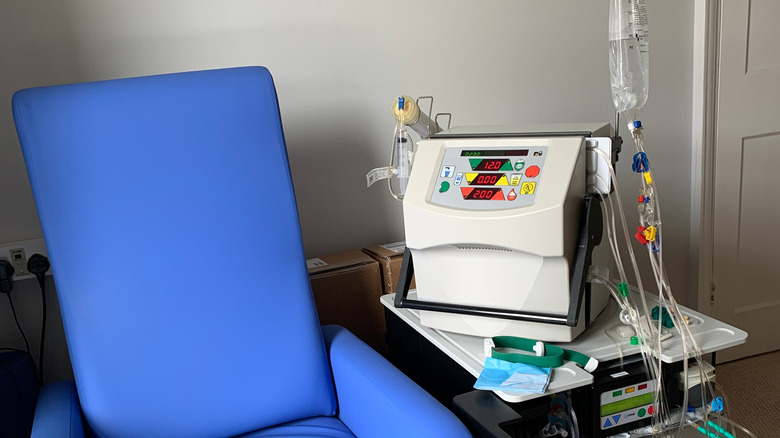The Different Stages Of Kidney Failure
Chronic kidney disease (CKD) is a condition in which the kidneys are damaged and cannot filter blood properly. CKD can lead to kidney failure, which is when the kidneys can no longer remove waste and excess fluid from the body. Kidney failure is divided into stages based on how much kidney function has been lost (via Verywell Health). The most common causes of chronic kidney disease include diabetes and high blood pressure. In addition, kidney disease can be caused by other health problems such as sickle cell anemia or polycystic kidney disease.
Experts use the eGFR (estimated glomerular filtration rate) blood test to measure the stages of kidney failure. This system determines how well or poorly your kidneys are working. People with kidney failure need to be frequently tested to accurately monitor the stages of kidney failure. Each stage of kidney failure is treated differently, so it is important to know when someone has reached every stage in order to provide effective treatment.
What to know about stage 1 kidney disease
Someone with stage 1 kidney disease has mild kidney damage. The eGFR for someone with stage 1 kidney disease is normal or only slightly decreased, and measures as 90 or more (via Verywell Health). This type of kidney damage can come from physical damage to the kidneys as well as symptoms more typical of chronic kidney disease like protein in the urine. Treatment for stage 1 kidney disease typically focuses on managing the underlying cause of the kidney damage. This may include changes to diet and lifestyle, medications, and other treatment options depending on the cause of the kidney disease. Managing stage 1 kidney disease is important as it can help prevent further damage to the kidneys and progression to stage 2 kidney disease.
Someone in this stage generally does not experience any symptoms. While kidney damage is mild, it is still important for people in this stage to take care of their kidneys. You can do this by staying active, maintaining a healthy weight, and staying hydrated. You can also control your blood sugar, stop smoking, and monitor your blood pressure. If you have kidney disease, it is also important that you have regular visits with your doctor to monitor the health of your kidneys.
What to know about stage 2 kidney disease
Stage 2 kidney disease is still mild with an eGFR between 60 and 89. People in this stage may also not experience any symptoms. The kidneys still do an adequate job in the body even though they are not completely healthy. People are usually diagnosed with stage 2 kidney disease while being treated for another condition like high blood pressure or diabetes (via Davita). Other reasons someone may find they have stage 2 kidney disease include discovering higher than normal levels of creatinine in the blood, protein in the urine, or evidence of kidney damage in an MRI or CT scan.
In stage 2 kidney disease, it is important to take steps to manage your condition and prevent further damage to your kidneys. If you have diabetes or high blood pressure, work closely with your doctor to control these conditions. You should also eat a healthy diet, get regular exercise, and stay well hydrated. Additionally, it is important to monitor your kidney function regularly with tests like the eGFR test so that you can identify any potential problems early on. With proper management and care, stage 2 kidney disease can usually be effectively managed and even reversed.
What to know about stage 3 kidney disease
Stage 3 kidney disease begins to present more serious symptoms than stages 1 and 2. The eGFR at this stage is between 30 and 59 (via American Kidney Fund). This stage is broken into two sub-stages: stage 3a, which means your eGFR is between 45 and 59, and stage 3b, which means your eGFR is between 30 and 44. People with stage 3 kidney disease usually have moderate kidney damage. This can lead to waste buildup in the blood and make it difficult for the kidneys to remove excess fluid from the body. As a result, people in this stage may experience fatigue, trouble sleeping, and increased urination. They may also lose their appetite, have trouble concentrating, and feel nauseous. In some cases, stage 3 kidney disease may also cause weight loss, itching, and swelling in the feet and ankles.
Doctors will treat stage 3 kidney disease by addressing your symptoms and addressing the health conditions that can lead to this disease if applicable. Treating high blood pressure, for example, may involve taking medications like ACE inhibitors and ARBs. Your doctor may also recommend that you stop taking any medications that can cause further damage to your kidneys, like nonsteroidal anti-inflammatory drugs (NSAIDs) and some types of arthritis medication. Because these can cause kidney issues, it is important that you tell your doctor about all medications you are taking if you have kidney disease.
What to know about stage 4 kidney disease
Stage 4 kidney disease is characterized as severe kidney damage. The eGFR at this stage is between 15 and 29. According to the National Kidney Foundation, this is the final stage before full kidney failure, so proper treatment is crucial to prevent moving to stage 5. Symptoms of stage 4 kidney disease may include swelling in the ankles and feet, increased urination, nausea, trouble sleeping, fatigue and weakness, loss of appetite, poor concentration, and difficulty thinking clearly.
Your doctor will likely recommend that you make lifestyle changes to manage your condition at this stage. This may involve making diet and exercise changes or potentially undergoing dialysis treatments. You may also be prescribed medications like ACE inhibitors or ARBs to help control high blood pressure as a cause of your stage 4 kidney disease. It is important that you talk to your doctor about any supplements or herbal remedies you are taking so that they can ensure these do not interact with any medications you are taking for your condition. At this point, your doctor will also go over plans for what to do if you do experience full kidney failure.
What to know about stage 5 kidney disease
Stage 5 kidney disease is complete kidney failure. The eGFR at this stage is below 15. This means that the kidneys are no longer able to function properly and waste begins to build up in the blood (via American Kidney Foundation). Symptoms of stage 5 kidney disease include all of the symptoms of earlier stages as well as shortness of breath, chest pain, and difficulty urinating. People with stage 5 kidney disease will need to undergo dialysis or a kidney transplant to survive.
Your doctor will likely recommend that you begin dialysis treatments at this stage. This involves using a machine to filter your blood and remove waste and excess fluid. You may also be placed on a waiting list for a kidney transplant. In some cases, people with stage 5 kidney disease may be able to receive a transplanted kidney from a living donor.
As you are undergoing treatments for stage 5 kidney disease, it is important to take good care of your health so that you can receive the best possible outcome from your treatment options. This may involve making healthy lifestyle changes like quitting smoking, getting plenty of exercise, and eating a healthy diet. It may also involve seeing specialists who can help manage any other medical conditions you have in order to prevent further damage to your kidneys.






